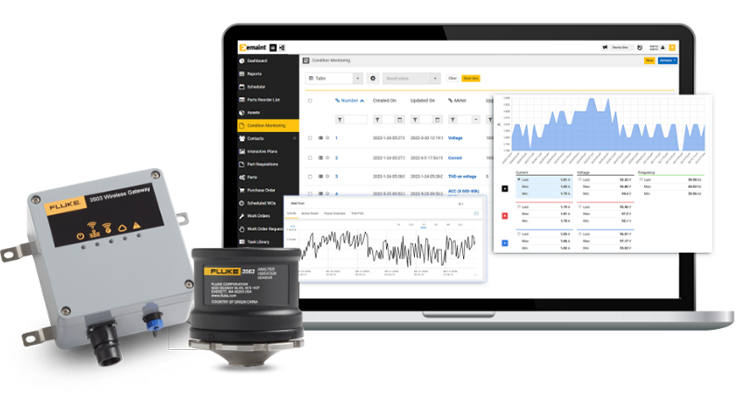The Industrial Internet of Things (IIoT) has led to a seismic transformation for the maintenance world – unlocking incredible opportunities to improve reliability, save costs, and optimize operations on every level. However, despite this potential, many maintenance teams still find themselves struggling to leverage IIoT technologies to their fullest advantage and implement an effective Reliability-Centered Maintenance (RCM) plan.
One of the most effective ways for maintenance teams to fast-track their reliability journey is by properly implementing a computerized maintenance management system (CMMS) software. A CMMS software like eMaint can standardize maintenance practices, increase on-time completion rates for preventive maintenance activities, track maintenance KPIs, manage parts inventory, and automate documentation of work-order histories, failures, and trends.
A CMMS is a central location where critical information can be made accessible from anywhere there’s internet service, eliminating data gaps and silos. A CMMS can also be used to create insightful dashboards where data can be collected and analyzed to drive quick, informed actions where they’re needed most.
Once all assets are set up in a CMMS, operators can enter work orders and have them automatically assigned to available technicians. Plus, when combined with condition monitoring technologies, a CMMS enables maintenance teams can use real-time data from the machines to determine the best time to act, instead of relying on inaccurate time-based maintenance schedules. With asset criticality rankings and asset hierarchies in place, maintenance teams can be sure that important assets and critical work are prioritized.
Leveraging a CMMS with Your Team to Improve Reliability
A CMMS can also help create a positive maintenance culture within your organization by enhancing your team’s understanding of the root causes of maintenance issues and creating a more focused approach to reliability. Leveraging the right maintenance management tools (like a CMMS) and properly using and implementing them will foster a culture of excellence within your maintenance organization.
Many manufacturers standardize maintenance across all their sites; however, it remains extremely common to have multiple, incompatible systems spread across several independently-operated plants that make standardization virtually impossible. A robust CMMS will provide a multi-site toolkit that makes it much easier to start with a single-site implementation. Once you have a solid foundation, you can build a roadmap for connected maintenance and reliability teams to adopt across many sites.
Thanks to CMMS user-friendly tools, maintenance managers can focus on increasing their work completion rates, evaluating each plant’s maintenance practices, and bringing them in line. Another common focus is to help increase plant accountability and improve adherence to standards. This is often accomplished by setting up gatekeepers and training individual site champions to be standard-bearers and avoid unauthorized changes.
Some CMMS software can integrate with technology such as vibration and power-monitoring sensors to amplify asset management.
Improve Reliability by Optimizing Your Inventory
Uptime is often the primary goal in today’s plants. That uptime depends on having an effective inventory-management system in place to decrease the lead time for critical spare parts. Successfully managing spare parts inventory is about having the right parts on hand and getting them to the right person when they’re needed.
A modern CMMS offers parts inventory management, as well as reports and dashboards to help track parts usage and lifespan. To do that, a CMMS identifies where parts belong in a physical inventory environment. Those parts can also be assigned different levels of criticality and be stocked using those levels. With increased availability for critical spare parts, maintenance managers often find they can help significantly increase plant reliability.
Harnessing predictive-maintenance strategies and gaining actionable insights depends on IIoT connectivity. With condition-monitoring sensors and software, potential failures are flagged before damage or downtime occurs.
The right CMMS software seamlessly integrates with technology such as vibration and power-monitoring sensors to amplify asset management. By viewing condition-monitoring data in your CMMS, you can help lower costs, reduce asset failures, and ultimately extend asset lifespan.
Seamlessly Track Your Maintenance Performance Indicators (KPIs)
It’s difficult to measurably improve plant reliability without tracking maintenance metrics. Maintenance KPIs (key performance indicators) help teams compare their performance with goals tied to a variety of factors, including machine failures, repair times, work backlogs, and maintenance costs.
A CMMS is among the best ways to track maintenance KPIs because it lets users create baselines to measure against and reveals opportunities for improvement. If you already use a CMMS, you can likely transform your existing data into measurable insights that help empower data-based decisions and ultimately improve reliability.
Maintenance KPIs can be bucketed into leading and lagging indicators. Leading indicators are about future events and include maintenance metrics such as Preventive Maintenance Compliance or Estimate vs. Actual Performance. A lagging indicator includes metrics such as Mean Time Between Failure (MTBF) and Mean Time to Repair (MTTR). To drive the greatest increases in reliability, CMMS KPI tracking should include a mix of both.
Improve Reliability with a CMMS Today
To ensure your CMMS is a success and that you get the most out of your system, follow these key steps:
Document standard work processes. It’s easier to identify potential failure and prep for compliance audits if your team has detailed documentation. Get started by setting priorities based on asset criticality, establishing work control functions, and defining and accounting for all labor and parts.
Plan and schedule work. Establish a planning and scheduling process. Monitor how much proactive work your team is doing and develop work schedules for planned work.
Manage MRO materials. Bridge the maintenance, repair, and operations (MRO) reliability gap by designating critical and/or capital spare parts, tracking warranty information, and documenting processes for refurbishment/repair.
Audit processes for continuous improvement. Treat your CMMS as your most valuable asset. Evaluate ongoing improvements year after year and conduct regular reviews of processes, workflows, and data to maximize value.

